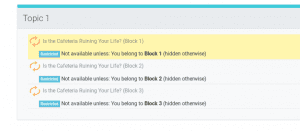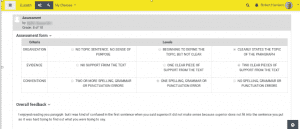On Monday and Tuesday of this week, I worked with Bryant 6th grade ELA teachers Mrs. Patricia Griffin and Mr. Dennis Dicks as they tried out the Moodle Workshop activity for the first time with their students.
To begin the process, Mrs. Griffin and Mr. Dicks developed a writing prompt based on an article students had recently read, entitled “Is the cafeteria ruining your life?” We then converted a grading sheet with which students were familiar into a grid-like rubric in the Workshop Module. The rubric included three criteria: Organization, Evidence, and Conventions. Each criterion had three levels.
The Process
 Students began the activity by re-reading the article, using the protocols Mrs. Griffin and Mr. Dicks had established previously using tools like newsELA. After reading, we introduced students to the Workshop using the following key points:
Students began the activity by re-reading the article, using the protocols Mrs. Griffin and Mr. Dicks had established previously using tools like newsELA. After reading, we introduced students to the Workshop using the following key points:
- Usually, when we do work in school, we turn it in to the teacher, who gives us feedback. But teachers are not the only people that can give us feedback.
- If others know what the expectation is (the rubric), they can also give us feedback and insight into our writing.
- For this activity we’re “turning it in” to our peers.
Students spent time pre-writing and writing their responses. The following day, after we allocated submissions to each student (3 of their peers, at random, as well as their own writing submission). Then we introduced them to the assessment phase, explaining…
- The Workshop Module gives two grades: one for what you write and one for how well you use the rubric to grade your peers’ and your own work.
- You will be grading yours and your peers’ work using the rubric. This is one form of feedback. But you will also be required to give at least one piece of actionable feedback, which was a simple setting on the module that requires students to enter something in the feedback box before saving their grade. This required us to also explain what actionable feedback was and give examples.
Students then assessed their peers. As they did this, Mrs. Griffin and Mr. Dicks spent time perusing the feedback students were giving and paused at a few points to give examples of the feedback that was being given and give advice as to how to make that better.

Thinking About Feedback
Following this activity, we discussed the experience and talked about the feedback some students received. Many students found the feedback helpful, and after asking some guiding questions, revealed to the group that the more specific the feedback was, the better it would help them. Students also expressed a little frustration with the tone of some of the feedback. This gave Mrs. Griffin and Mr. Dicks the opportunity to discuss constructive criticism and the need for kind words when doing so.
This activity was a great experience for these students and prepared them to be able to do so on a larger scale and possibly with higher stakes. They now understand the process and know what to expect. But even more, the experience of giving and receiving feedback, as well as talking honestly about the value of certain types of feedback, can help students going forward to be able to give effective feedback to their peers and solicit the same from them (ISTE Standards for Students, Indicator 1c: Students use technology to seek feedback that informs and improves their practice and to demonstrate their learning in a variety of ways.)
What Comes Next?
As you can see, what happens before and after a Workshop is just as valuable as what happens during. These teachers now have some other options to follow up with the activity. We discussed the following possibilities, for instance:
- Have students re-write their writing submission on a Moodle Assignment or Google Classroom assignment, using the feedback they were given on the rubric and the actionable feedback given by each student. Students could also follow this up with an explanation of how they changed their writing, citing specific feedback.
- Discuss the students how the rubric could be improved now that they have had the opportunity to use it to assess. This can be a valuable discussion and students would inevitable come to the discussion with concrete ideas, since many students expressed a little bit of discontent with some of the wording and breakdown of the descriptors. Giving students the opportunity to modify the rubric and then using it on a subsequent activity would be immensely valuable in empowering student ownership and further establishing a healthy culture in the classroom.
- Have students evaluate the feedback by creating a rubric for feedback, itself. This can further help students know what to ask for when seeking feedback.
